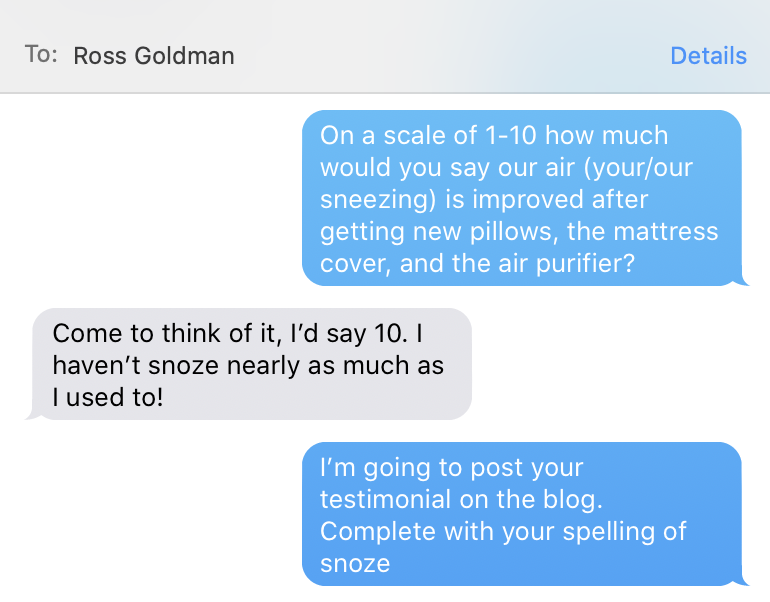Working On Improving Our Indoor Air Quality
/Ross and I are naturally sneezy people. Or are we? We were noticing BOTH of us were particularly sneezy all year long, no matter the season, and it didn’t seem quite right. So, we took measures to get to the root of the issue.
For additional context on our nasal passages (I know you’re so curious), I was having some pretty bad sinus infections a few years ago. I went to an allergist to see if there’s something I’m super sensitive to. I did the allergy panel and it’s clear I get a strong reaction to dust mites. ew. Ross hasn’t seen a doctor, but I can attest that the guy is super sneezy, like all day any day. There’s definitely something that bothers both of us, no matter the season.
We went through all of the most common things to improve air quality at home:
✔ dust and deep clean everything frequently
✔ avoid household cleaners, products, paints, and furnishings with VOCs
✔ run hood vents and bath fans when range and shower are in use
✔ open doors and windows for daily circulation
✔ upgrade the whole-house air filter to a higher MERV rating then change on schedule and have ducts professionally cleaned
✔ maintain humidity levels
✔ avoid burning things in the home
✔ remove building materials with asbestos or other contaminents
✔ ensure carbon monoxide sensor is working
✔ keep houseplants for air cleansing but ensure they aren’t too wet and growing mold
✔ check for mold/mildew throughout the home
✔ use the power of the sun to clean textiles
I could definitely do better about not killing my houseplants, but I feel like we’re pretty on point with each of the other items. Over the last five years, we’ve overhauled the entire house and been in control of all the finishes and we’ve cleaned every surface. Our HVAC was entirely replaced, walls and floors got all new coatings, we avoid VOC cleaners, paints, and home products, and you know I love cleaning.
I started to worry there was a really bad mold issue hiding under the house or in the pre-renovated kitchen. I decided that we’d do demolition on the kitchen, and if everything was okay, then we’d look into what other issues could be the culprit. The good news was there was no crazy mold issue in the old kitchen! So that meant I had more research to do.
The things we aren’t able to control are actually some pretty big contributors to poor air health:
✘ Southern California wildfire season
✘ city dwelling pollution
✘ living under the flight path of airplanes flying into a major airport
We’re lucky to be only a few miles from the coast so we have a pretty constant breeze that keeps our air fresh and circulating. But our coastal air doesn’t prevent toxic wildfire pollution, unfortunately.
The first thing I did was turn attention to the bed because of the amount of time we spend sleeping and it’s a prime spot for my allergen - dust mites. We already were using natural fiber sheets and pillows, so I knew it wasn’t likely to be an issue of coatings or fire-retardant chemicals in the fibers. But I did notice the linen shed a lot, so I switched over to all cotton. Then, I switched out the pillows even though I washed ours pretty frequently. The new pillows are hypoallergenic, green guard gold certified, and free of by-product fillers. Then, I finally listened to the allergist and bought the doctor-recommended brand of dust-mite and allergen-proof mattress cover.
We slept for a few weeks with our new bedding and we definitely saw an improvement! Does this mean our mattress is full of filthy dust mites? Maybe? Probably. Ew.
With improved sneeziness, I continued dusting and cleaning regularly. I even started wearing my cloth masks when I did heavy dusting to keep the gunk out of my nose. I suppose one good thing that came from the pandemic is more awareness of what we’re breathing in and access to effective face coverings.
I still wasn’t fully satisfied with what we were doing to ensure we had the best air quality. There are wildfires and city pollution out of our control, and becoming pregnant had us both thinking more about my health and our future little one’s health growing up in our home. So, we got an air purifier. Coway is a trusted brand, this model has 10,000 reviews for an average 4.5 rating, and has a HEPA air filter (not all the popular purifiers do). I actually made the decision to get this purifier because it was recommended by Wirecutter - my go-to review source when product offerings are beyond overwhelming. There are a bunch of other great air purifiers on the market (like this popular competitor) but this is the one I picked and we’re pleased with it!
Since getting the purifier, we’ve left it running 24/7 to do a deep clean and see what we could learn about our home’s air. We moved it around from room to room but it mostly hangs out in the bedroom because I spend literally half of my life in there. We’ve had it for two months (February and March - not wildfire nor allergy season and not during any construction). Ready to see the filters?
Yummy! This is after 60 days of use.
It’s obviously filtering some big dusty bits, but I’m hopeful it’s been trapping even more particles we can’t even see.
After using the air purifier for a pretty short time, we noticed that it would randomly ramp up and do some heavy filtration. It has a blue light for constant filtering, then goes to purple when it senses something it needs to cleanse, then turns red when it notices a serious air issue. It would be sitting pretty at blue for an hour, then suddenly ramp up to red for a few minutes, then go back down to blue. I was so curious what was going on. So, in my typical research fashion, I decided to get one more item that I wanted in my air-purifying collection.
I got an air quality monitor! I actually wanted this from the beginning of my air quality journey. Is it any surprise that this lover of data and experimentation would want a gadget to measure her air? I mean, you saw how I measured the electricity throughout my home, right? I got this cutie on the recommendation, again, of Wirecutter. They said the one I got and this one were both recommended, but the latter is double the price and has wifi connectivity that I don’t need. The air quality monitor measures PM2.5, AQI, TVOC, and HCHO.
Now, whenever the air purifier ramps up to the red light, I grab the monitor to see what it says to better understand what is happening with our air. I’m happy to report that when one of the gadgets says there’s a high measurement, the other one does, too. So I know they aren’t faulty. What I also do is take the monitor to sit near me in the office, and if it alerts me that there’s a high measurement, I can drag the purifier to the other room to clean the air.
The other day when I was in the backyard, a weird odor wafted over - probably from nearby construction. I grabbed the monitor and watched the AQI and PM2.5 numbers climb into the red zone (the monitor has green/yellow/red lights). Then, I stayed inside until the numbers went back to a healthier range.
So, there you have it. We’re going to continue to work on identifying what makes our air purifier jump into the red zone, and we’re going to continue to be aware of our home’s air health. But in the meantime, I’m glad to have a gadget to make me feel more in control of the situation, and a purifier to work behind-the-scenes on our air quality. Maybe we’ll add more purifiers to the house in different rooms, maybe we’ll upgrade to a whole-house air purifier, we’ll see!
How is our sneezing going? Well, I asked Ross for his honest opinion (he didn’t know I was writing this blog post).
10! I agree that there’s been a dramatic improvement for both of us.
Also, he knows the correct word is “sneezed” but it’s just a part of our family language to say snoze (sneezed) and squoze (squeezed) and snew (snowed). But like, why isn’t the past tense of sneeze actually snoze??
I’d love to hear what other folks are doing to improve their air quality. I like hearing your tips and know others would appreciate it too, so drop them in the comments.































